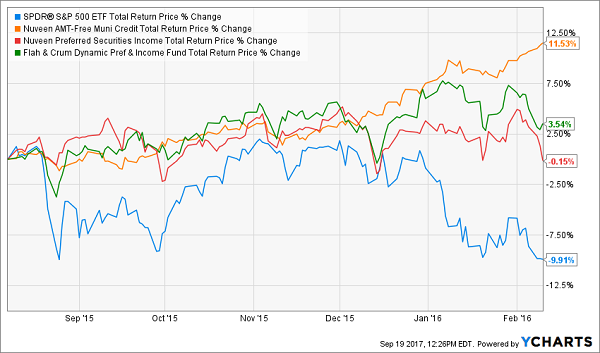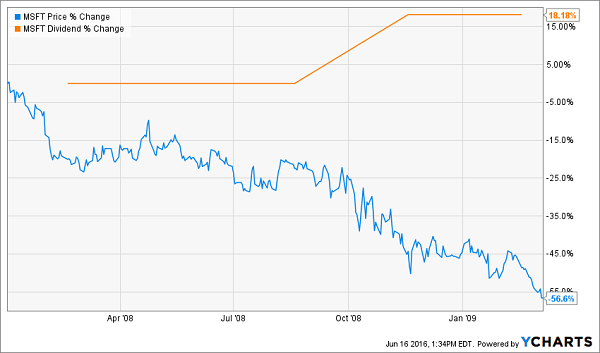You’re not the only one worried about high stock prices.
The lurking (and perhaps overdue) bear has other income investors worried, too. So let’s talk about the best buys for those of you worried about a stock market pullback of 10%, or 15%, or more.
We’ll start with some stalwarts from our Contrarian Income Report portfolio that weathered the last storm. Ironically (and probably fittingly) it happened off the bat – we launched our service, and the S&P 500 promptly dropped 10%!
No problem for us, though. In fact, subscribers who focused on their own holdings rather than the financial news may have missed the broader carnage altogether.
Our core bond fund holdings (orange, red and green lines below) not only continued to pay their 7% dividends, but they also averaged a 5% gain while stocks were swooning:
What Pullback? Contrarian Bond Funds Sail
 My bet is that carefully curated bond funds will repeat their resilience during the next pullback. But really, it shouldn’t matter if you have a true “no withdrawal” portfolio that lets you focus entirely on dividends and ignore price action altogether. Here’s why.
My bet is that carefully curated bond funds will repeat their resilience during the next pullback. But really, it shouldn’t matter if you have a true “no withdrawal” portfolio that lets you focus entirely on dividends and ignore price action altogether. Here’s why.
We Avoid Reverse Dollar Cost Averaging
Most investors practice “buy and hope” investing. They pick up shares, and root for them to appreciate in price. And that’s it.
These first-level types have no plan on how to generate cash flow from their holdings. They think they’ll sell someday, and hope it’s at a higher price. But they don’t have a set game plan to sell and methodically harvest cash from the portfolio they worked so hard to build.
Many financial advisors step into this void, pitching a “4% withdrawal rate.” These guys (who have not retired successfully themselves, by the way) say that you can safely withdraw 4% or so every year from your portfolio and use this as spending money.
Generally, they’re right. But when they’re wrong, it’s disastrous.
The fatal flaw with the 4% annual withdrawal strategy for retirement is that every few years, you’re faced with a chart like this:
Selling Here is Reverse Dollar Cost Averaging
 And the 4% withdrawal “strategy” means you’re forced to take out money at exactly the wrong time. If you don’t have enough dividend income to support your family at the time, you must sell shares for additional income.
And the 4% withdrawal “strategy” means you’re forced to take out money at exactly the wrong time. If you don’t have enough dividend income to support your family at the time, you must sell shares for additional income.
Sadly you’re forced to practice reverse dollar cost averaging – you sell even more shares when prices are low, reducing your upside when markets normalize. This is the same phenomenon that built your wealth, except working against you!
The solution is to transition away from ever having to sell a share. And meaningful dividends of 6%, 7% or 8% are a great solution. They give you a means to “cash out” your nest egg on a monthly and quarterly basis, without being forced to sell low (or sell ever).
In fact, you can do even better – you can step in and buy when prices are low and yields are high.
Because Upside Matters, Too
You’ve probably been told you should dump—or at least reduce—your stock holdings and focus on fixed-income investments as you near and enter retirement. It sounds like a smart move, but going lean on stocks leaves you open to two big risks:
- That you’ll outlive your savings, and
- You’ll miss out on the long-term gains only the stock market can offer.
So why not blend a portfolio of 7%+ bond funds with smart stock picks that provide you with similarly high yields with upside to boot? Sure, they may “sell off” a bit if the markets pull back. But who cares. Like a savvy rich speculator, you’ll be able to step in and buy more shares when they are cheap – without having to worry about your next capital withdrawal.
Let’s take healthcare landlord Omega Healthcare Industries (OHI). The firm’s payout is usually generous, and always reliable – yet, for whatever reason, its sometimes-manic price action gives investors heartburn.
But it shouldn’t. It’s actually quite predictable. Check out the chart below, and you’ll notice:
- When the stock’s yield is high (blue line), its price is low. Investors should buy here.
- When the stock’s price is high (orange line), its yield is low. Investors should hold here, and enjoy their dividend payments.
Investing is Easy: Buy When Yield (Blue Line) is High
 Of course this simple timing strategy is much easier to employ if you don’t need stock prices to stay high to retire. Most investors who sell shares for income spend their days staring at every tick of the markets.
Of course this simple timing strategy is much easier to employ if you don’t need stock prices to stay high to retire. Most investors who sell shares for income spend their days staring at every tick of the markets.
You can live better than this, generate more income and even enjoy more upside by employing our contrarian approach to the yield markets. We live off dividends alone. And we buy issues when they are out-of-favor – so that our payouts and upside are both maximized.
— Brett Owens
8% Dividends, Paid Monthly, Make Retirement Even Easier [sponsor]
And by the way, you can even use my no withdrawal strategy to make sure you’re:
- Banking 8% annual dividends,
- Enjoying additional price upside, and
- Getting paid monthly to boot!
If this interests you, I’d recommend starting with my all-star retirement portfolio. It contains 8 of the absolute best preferred stocks, REITs and CEFs out there.
If you’re scratching your head at these terms, you’re not alone. These are investments that you won’t hear about on CNBC or read about in the Wall Street Journal. Which is why we have these fantastic opportunities available in this “no yield” world.
I’ll explain more about them in a minute. I’ll also show you why my 8% eight-pack is well diversified across all types of investments and sectors, and the cash flows funding these dividends will do well no matter what happens in the broader economy or stock market.
Plus, as I hinted, relentless dividend growth means your 8% yield will be more like 10% in short order.
I’m ready to take you inside this “no-worry” retirement portfolio now. Click here and I’ll show you the 8 bargain investments inside it and give you their names, tickers, buy-under prices and much more.
Source: Contrarian Outlook

